World War II marked a pivotal moment in military technology, introducing groundbreaking advancements in weaponry, communication systems, and strategic frameworks. These innovations not only transformed combat effectiveness during the war but also established the foundation for modern military operations and defense capabilities. The legacy of WWII technology continues to influence contemporary warfare, shaping the evolution of military strategies in response to geopolitical challenges.
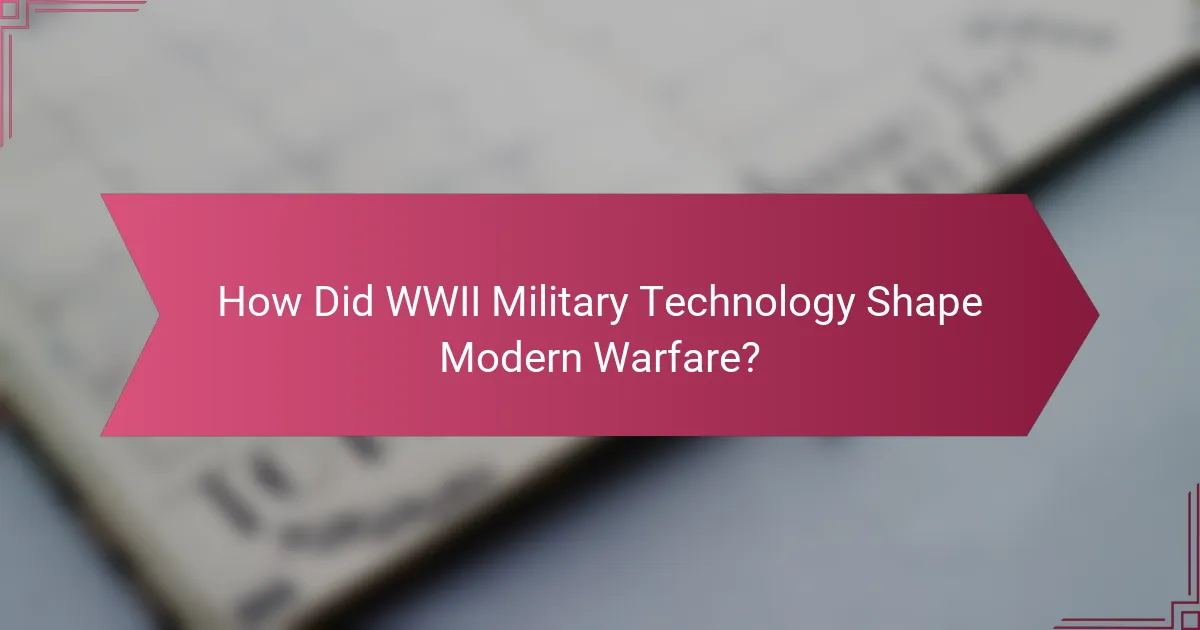
How Did WWII Military Technology Shape Modern Warfare?
WWII military technology significantly influenced modern warfare by introducing advanced weaponry, communication systems, and strategic frameworks. These innovations laid the groundwork for contemporary military operations and defense capabilities.
Influence on weapon systems
The development of weapon systems during WWII, such as tanks, aircraft, and naval vessels, set new standards for firepower and mobility. For example, the introduction of the tank revolutionized ground warfare, leading to faster and more dynamic battles.
Modern weapon systems, including drones and precision-guided munitions, can trace their roots back to the technological advancements made during this period. The emphasis on versatility and adaptability in weapon design continues to shape military procurement and development today.
Impact on military strategy
WWII saw the emergence of combined arms tactics, where different military branches worked together to achieve strategic objectives. This approach has evolved into joint operations in modern warfare, emphasizing coordination among air, land, and naval forces.
Additionally, the concept of total war, where entire nations mobilize resources for conflict, remains relevant. Modern military strategies often incorporate economic and cyber warfare, reflecting the lessons learned from WWII about the interconnectedness of military and civilian sectors.
Legacy in defense technology
The legacy of WWII military technology is evident in today’s defense systems, which prioritize technological superiority. Innovations such as radar, jet propulsion, and early computing have paved the way for advanced surveillance and information warfare capabilities.
Furthermore, the emphasis on research and development during WWII established a culture of innovation within military organizations. This focus continues to drive advancements in defense technology, ensuring that armed forces remain prepared for evolving threats in a complex global landscape.
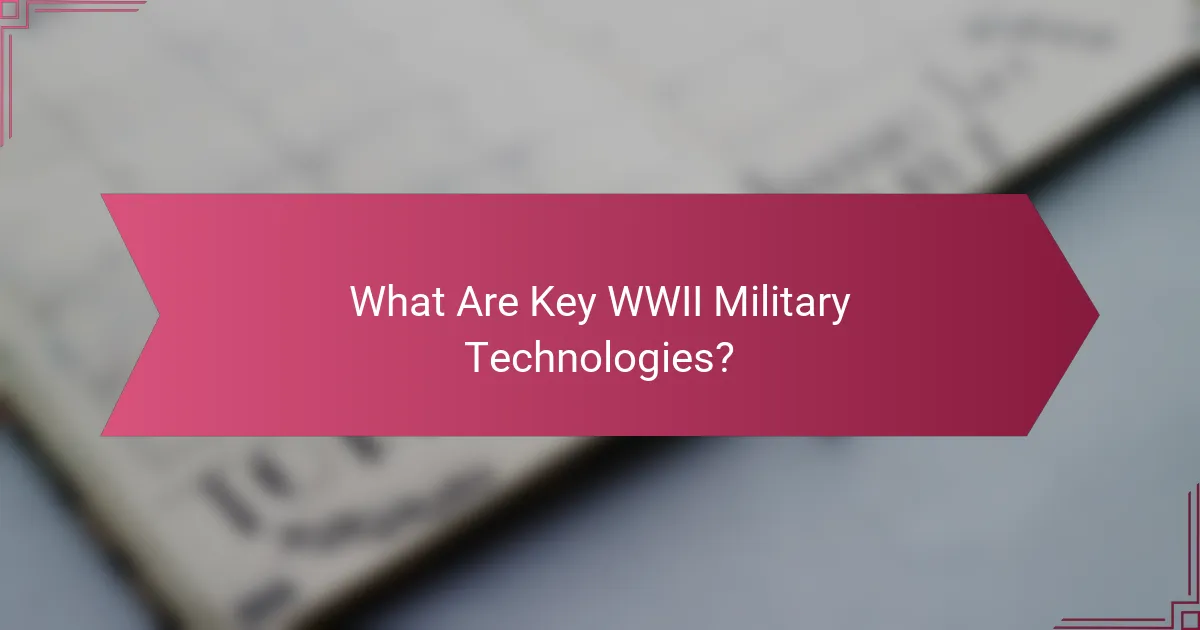
What Are Key WWII Military Technologies?
Key WWII military technologies included advancements in tanks, aircraft, and naval systems that significantly influenced modern warfare. These innovations not only enhanced combat effectiveness during the war but also laid the groundwork for future military strategies and technologies.
Tanks and armored vehicles
Tanks and armored vehicles revolutionized ground warfare during WWII by providing mobility, protection, and firepower. The introduction of designs like the German Panzer and the Soviet T-34 showcased the importance of speed and armor in combat scenarios.
Modern tanks often incorporate composite armor and advanced targeting systems, reflecting lessons learned from WWII. When considering tank deployment, factors such as terrain, enemy capabilities, and logistical support are crucial for maximizing effectiveness.
Aircraft advancements
Aircraft advancements during WWII included the development of faster, more maneuverable fighters and strategic bombers. Innovations like the jet engine and radar technology changed aerial combat dynamics, allowing for greater reach and effectiveness in missions.
Today’s military aircraft continue to build on these WWII foundations, utilizing stealth technology and precision-guided munitions. Understanding the evolution of aircraft can help military planners assess air superiority and strike capabilities in modern conflicts.
Naval innovations
Naval innovations in WWII, such as aircraft carriers and submarines, transformed naval warfare by emphasizing mobility and strategic positioning. The shift from battleships to carriers as the centerpiece of naval power highlighted the importance of air support in maritime operations.
Modern naval strategies often incorporate lessons from WWII, focusing on multi-domain operations and integrated defense systems. When evaluating naval capabilities, consider the balance between surface ships, submarines, and air power for effective maritime dominance.
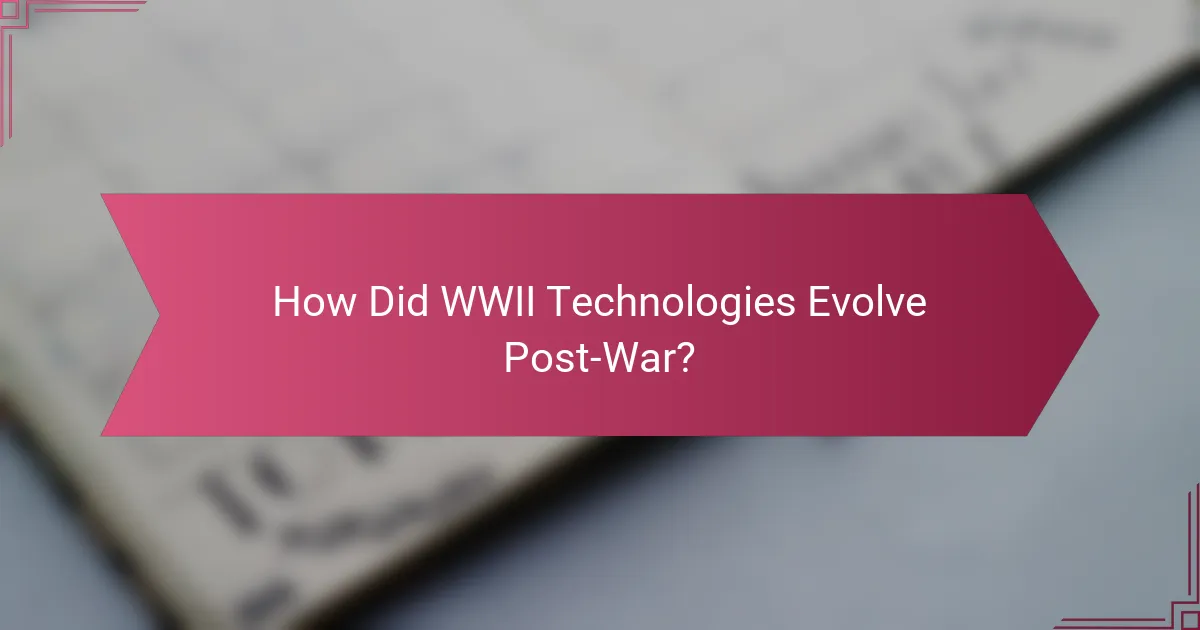
How Did WWII Technologies Evolve Post-War?
Post-World War II, military technologies evolved significantly, driven by geopolitical tensions and the onset of the Cold War. Innovations from the war laid the groundwork for advanced systems in weaponry, communication, and strategy that shaped modern military capabilities.
Transition to Cold War technology
The transition to Cold War technology marked a shift from conventional warfare to a focus on deterrence and strategic dominance. This era saw the development of advanced aircraft, missile systems, and surveillance technologies, which were essential for maintaining a competitive edge against rival nations.
For instance, the introduction of jet engines in fighter aircraft allowed for greater speed and agility, while radar technology improved detection capabilities. Countries invested heavily in research and development, leading to innovations that would define military operations for decades.
Development of nuclear weapons
The development of nuclear weapons post-WWII transformed global military strategy and international relations. The atomic bomb, first used in 1945, prompted nations to pursue nuclear arsenals as a means of deterrence, fundamentally altering the landscape of warfare.
By the late 1940s and early 1950s, the United States and the Soviet Union had developed hydrogen bombs, which were significantly more powerful than their predecessors. This arms race led to the establishment of various treaties aimed at controlling nuclear proliferation, such as the Nuclear Non-Proliferation Treaty (NPT) in 1968.
Advancements in communication systems
Advancements in communication systems during the post-war period were crucial for military coordination and strategy. The introduction of satellite technology in the 1960s allowed for real-time communication and reconnaissance, enhancing operational effectiveness.
Military forces began utilizing secure communication channels, such as encrypted radio transmissions, to protect sensitive information. The development of computer networks in the latter half of the 20th century further revolutionized command and control capabilities, enabling faster decision-making and improved situational awareness on the battlefield.

What Are the Modern Applications of WWII Innovations?
Modern military applications of World War II innovations are evident in various aspects of contemporary warfare, including technology integration, defense contracting, and military training simulations. These advancements have shaped strategies and capabilities, ensuring that lessons learned from past conflicts continue to influence current operations.
Integration in current military operations
World War II innovations, such as radar, jet propulsion, and advanced communication systems, are integral to today’s military operations. For example, modern air forces utilize radar technology for surveillance and targeting, enhancing situational awareness and response times. Additionally, the principles of combined arms warfare developed during WWII are still applied in joint operations among air, land, and naval forces.
Furthermore, the use of unmanned aerial vehicles (UAVs) has evolved from early reconnaissance missions in WWII to sophisticated drones capable of surveillance, targeting, and even combat roles. This integration of technology allows for more effective and efficient military responses in various scenarios.
Use in defense contracting
Defense contractors today leverage WWII-era innovations to develop and produce advanced military systems. Companies often focus on enhancing legacy technologies, such as improving the accuracy of artillery systems or upgrading communication networks initially designed during the war. This approach not only maintains the relevance of historical advancements but also drives innovation in defense capabilities.
Moreover, government contracts often prioritize companies that can demonstrate a clear understanding of historical military technology applications. This creates a competitive landscape where firms must balance modernization with the foundational principles established during WWII.
Influence on military simulations
Military simulations today are heavily influenced by strategies and technologies developed during World War II. These simulations often incorporate historical scenarios to train personnel in tactics and decision-making processes. By analyzing past conflicts, military leaders can better prepare for contemporary challenges and improve operational effectiveness.
Additionally, simulation technologies have advanced significantly, allowing for realistic training environments that replicate WWII-era battles. This not only aids in understanding historical tactics but also fosters innovation in developing new strategies that build on past lessons.
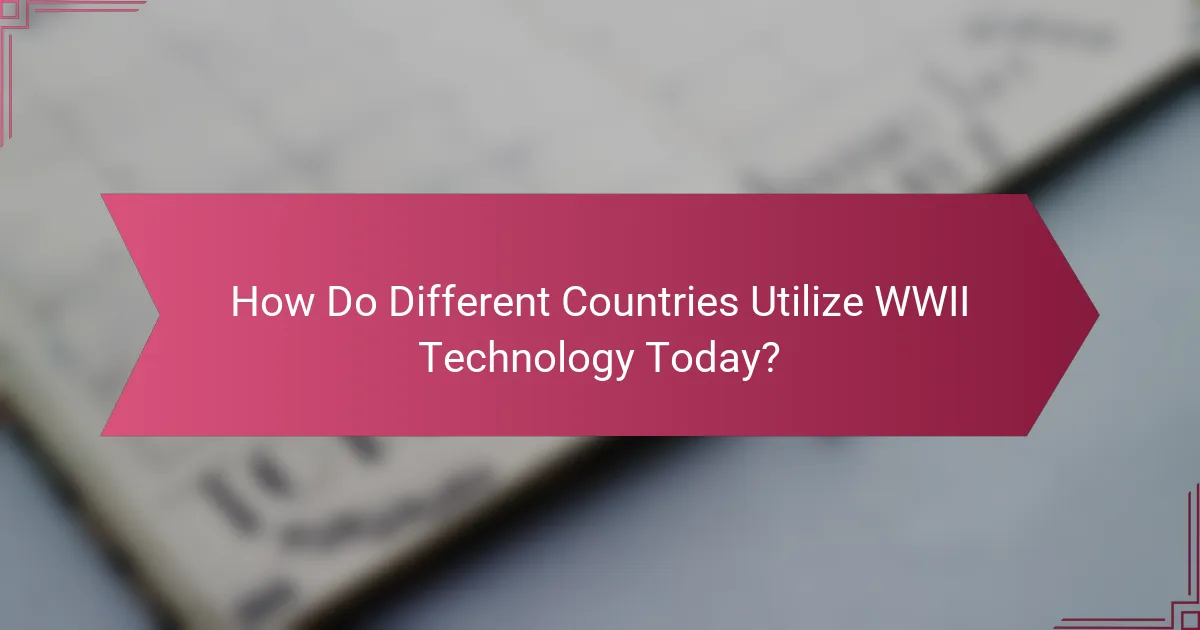
How Do Different Countries Utilize WWII Technology Today?
Many countries continue to adapt and integrate World War II military technology into their modern defense strategies, enhancing their capabilities while addressing contemporary threats. This includes advancements in aircraft, naval vessels, and ground forces, often leveraging historical designs and principles to improve efficiency and effectiveness.
United States military applications
The United States has effectively modernized WWII technology, particularly in aviation and naval warfare. Aircraft designs from that era, such as the B-17 and P-51, have influenced current stealth bombers and fighter jets, focusing on speed and maneuverability.
Additionally, the U.S. Navy utilizes WWII-era principles in aircraft carrier operations, emphasizing the importance of naval power projection. Modern carriers, while technologically advanced, still rely on tactics and strategies developed during the war, ensuring they remain central to U.S. military operations.
European defense strategies
European nations have incorporated WWII technology into their defense strategies by focusing on collaborative efforts and shared resources. NATO, for example, has seen member countries enhance their military capabilities through joint exercises that often reference tactics from WWII.
Countries like Germany and the UK have modernized their armored vehicles and artillery systems, drawing inspiration from WWII designs. This includes improving mobility and firepower while ensuring compliance with contemporary regulations and operational standards.
Asian military advancements
In Asia, countries like Japan and South Korea have adapted WWII technology to bolster their defense systems. Japan’s Self-Defense Forces have focused on naval technology, enhancing destroyers and submarines with advanced electronics and weaponry, while still drawing from historical naval strategies.
South Korea has also modernized its military equipment, including tanks and fighter jets, using WWII technology as a foundation for innovation. This approach allows for a blend of historical effectiveness with modern capabilities, ensuring readiness against regional threats.
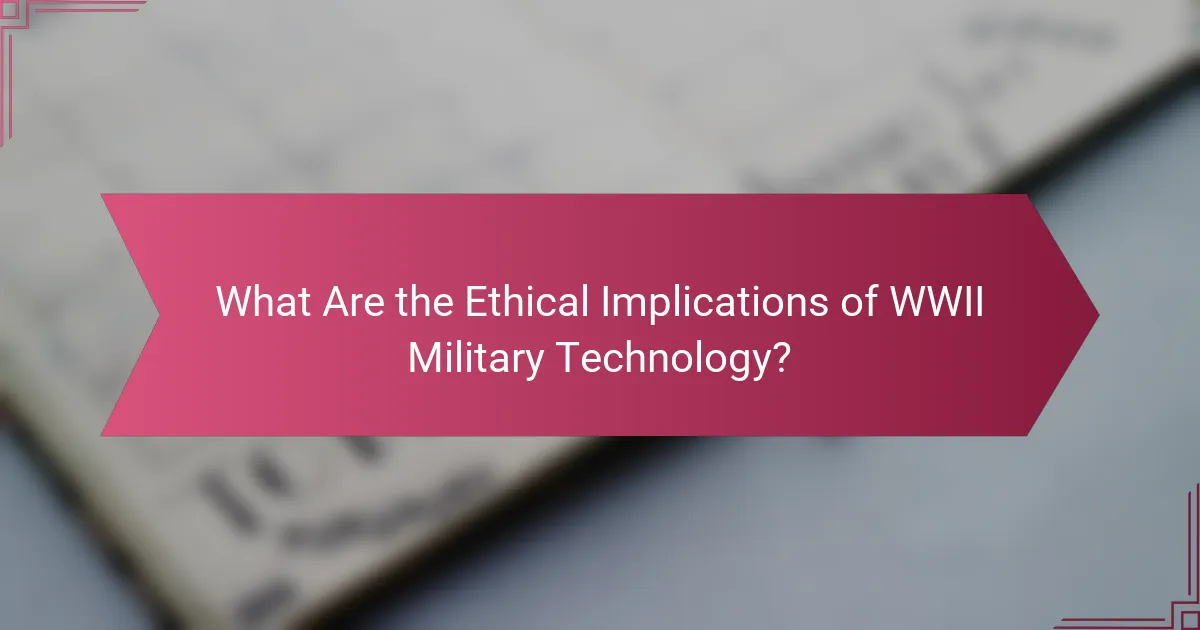
What Are the Ethical Implications of WWII Military Technology?
The ethical implications of WWII military technology revolve around the moral responsibilities of using advanced weaponry and tactics that emerged during the conflict. These technologies not only changed the nature of warfare but also raised significant questions about the impact on human life and the principles of just war.
Debates on warfare ethics
Debates on warfare ethics during and after WWII focus on the justification of using technologies like atomic bombs and aerial bombardments. Critics argue that such actions violate principles of proportionality and discrimination, which dictate that combatants should distinguish between military targets and civilians.
Proponents of these technologies often cite the necessity of ending the war swiftly to save lives in the long term. This ongoing debate highlights the tension between military necessity and humanitarian considerations, prompting discussions on the moral limits of warfare.
Impact on civilian populations
The impact of WWII military technology on civilian populations was profound, with millions affected by bombings, chemical warfare, and other advanced weaponry. Cities like Hiroshima and Nagasaki serve as stark reminders of the devastating consequences of nuclear weapons, leading to long-term health issues and environmental damage.
Additionally, the use of strategic bombing campaigns resulted in significant civilian casualties and destruction of infrastructure, raising ethical questions about the acceptable costs of achieving military objectives. The legacy of these actions continues to influence contemporary discussions on civilian protection in armed conflicts.
Regulatory frameworks
Regulatory frameworks addressing the ethical implications of military technology have evolved since WWII, with treaties like the Geneva Conventions and the Treaty on the Non-Proliferation of Nuclear Weapons (NPT) establishing guidelines for the conduct of war and the use of nuclear arms. These frameworks aim to limit the humanitarian impact of warfare and promote accountability among nations.
However, enforcement of these regulations remains challenging, as compliance often depends on the willingness of states to adhere to international norms. The ongoing development of new military technologies, such as drones and cyber warfare capabilities, raises further questions about the adequacy of existing regulations to address modern warfare’s ethical dilemmas.
